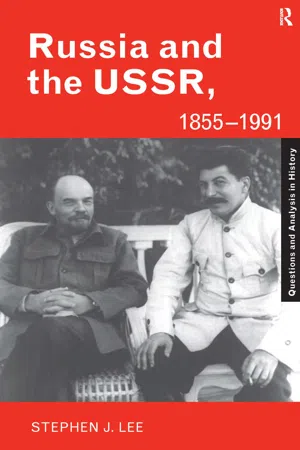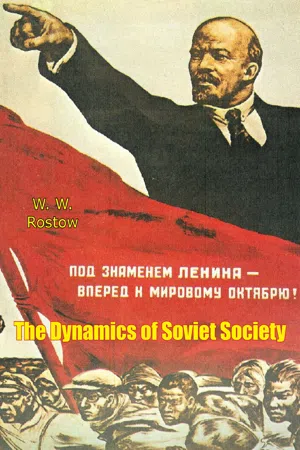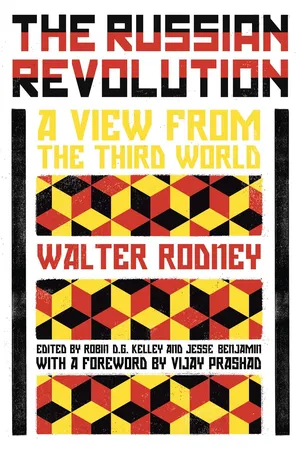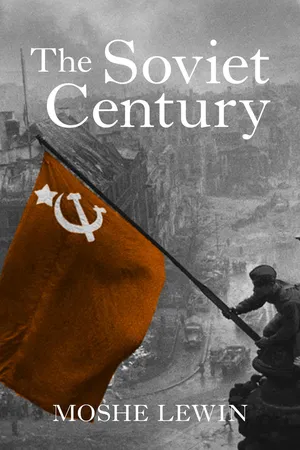History
Tsarist and Communist Russia
Tsarist Russia refers to the period of rule by the Russian tsars, characterized by autocracy and a rigid social hierarchy. Communist Russia, on the other hand, emerged after the Bolshevik Revolution in 1917, led by Vladimir Lenin, and was marked by the establishment of a socialist state, collectivization of agriculture, and centralized economic planning under the Communist Party.
Written by Perlego with AI-assistance
Related key terms
9 Key excerpts on "Tsarist and Communist Russia"
- eBook - ePub
Russia and the USSR, 1855–1991
Autocracy and Dictatorship
- Stephen J. Lee(Author)
- 2020(Publication Date)
- Routledge(Publisher)
IDEOLOGIES AND REGIMESANALYSIS 1: WHAT WERE THE MAIN FEATURES OF THE IDEOLOGIES OF TSARIST AUTOCRACY AND SOVIET COMMUNISM?
During the century and a half since 1850 Russia experienced a wider range of political change than any other European state. Until 1906 the political system was based on autocracy, which survived, in theory if not in practice, until March 1917. Between October 1917 and the end of 1991 the official ideology was Marxism-Leninism, usually referred to as Communism. For a brief period, between March and October 1917, Russia experienced less extreme alternatives in the form of moderate socialism and liberal democracy. Both of these had opposed autocracy but, through their failure to achieve a permanent cooperation after its downfall, let in a system that was to dominate the twentieth century.Tsarist autocracy
Within the context of Russia, autocracy meant the undiminished and undiluted exercise of the power of the sovereign. The Tsar was an absolute monarch in several senses. Political power came from God and its exercise owed nothing to any elected body; sovereignty was a trust, which was undivided and indivisible. On the other hand, the purpose of power was not the enhancement of the personal interest of the Tsar, since distorted autocracy was the worst form of tyranny. Instead, the Tsar carried a great burden – to uphold the social hierarchy and ensure the welfare of the people. The autocrat had the support of the Russian Orthodox Church, which established a special relationship with the Romanovs and a vital place within the political and social hierarchy.The exercise of the autocratic power varied from Tsar to Tsar. The general pattern of Russian history was either dominance by strong rulers (such as Ivan III, Ivan the Terrible, Michael Romanov, Peter the Great, Catherine the Great and Alexander I) or by political vacuums and weak rulers (such as Peter II, Peter III and Paul). There was very little between the two extremes and the last three Tsars, Alexander II (1855–81), Alexander III (1881–94) and Nicholas II (1894–1914), were particularly conscious of this. They all emphasised their autocratic powers and had others, whether official mentors or strong-willed consorts, to provide constant reminders of their responsibilities. - eBook - ePub
- John R. Barber(Author)
- 2011(Publication Date)
- Collins Reference(Publisher)
CHAPTER 10Soviet Russia—the FirstCommunist State (1917-1941)March 1917: The Romanov autocracy falls to popular revolt. April 1917: Lenin presents his April Theses to the Bolsheviks. November 1917: The Bolshevik Revolution occurs. March 1918: Russia surrenders to Germany at Brest-Litovsk. Mid-1918: The Allies intervene in Russia, and civil war begins July 1918: The tsar and his family are executed. 1920: Communists win the Civil War. 1921: Lenin establishes his New Economic Policy (NEP). 1924: Lenin dies. 1928: Stalin begins his rule. 1931: A famine strikes Soviet Ukraine. 1934: Kirov’s murder marks the onset of Stalin’s purges. 1936-1938: Stalin carries out his Great Purge. The Russian Ancien Regime remained nearly intact throughout the Modern era. No other European state had such antiquated institutions. Severe stresses built up during the 1800s as this system became less and less adequate to meet the needs of Russian society. Reformers and rebels tried to change or destroy the tsarist structure, and by the latter 1800s, even the imperial government took up the cause of modernization. Industry progressed rapidly as a result, but sociopolitical institutions remained too archaic. Revolutionaries and the ruling regime continued their brutal fight.The persistence of backward conditions in Russia in the early twentieth century and the bitter struggle of forces contending to save, reform, or destroy the old regime made the state extremely fragile. In this weakened condition, the empire marched enthusiastically into the First World War in 1914. This great conflict killed masses of Russians, depleted national resources, and wrecked the economy. Under the strain of this crisis, the autocratic state collapsed in early 1917.The leaders who first took charge after the overthrow of the tsarist system favored the construction of a parliamentary and capitalist state. Within months, a Bolshevik revolution swept this liberal regime from power. The victors then began to build the world’s first Communist state. - eBook - ePub
- W. W. Rostow, Alfred Levin(Authors)
- 2020(Publication Date)
- Barakaldo Books(Publisher)
It is thus the conclusion of this stage of the argument that even before 1917 the inheritance of an important element in Marx’s political theory converged with the bitter and practical experience of conspiracy, and with aspects of nineteenth-century Russian political thought. These converging influences gave to Lenin and his colleagues a fundamental bias in the following form: when a choice had to be made between a course of action which would enhance the power of their own political group as opposed to its being in conformity with Marxist doctrine, the substantive goals of revolution, the broad ideological aims and traditions of the progressive movement, or the majority will of the peoples concerned, the choice would lie on the side of short-run political realism and practice. It is in this precise sense that Aristotle’s subtle definition of tyranny, which appears at the beginning of this book, directly applies to the evolution of the Soviet state. In some instances the ideological inheritance of the revolution converged with the pursuit of power; in many instances there was conflict—consistently resolved and enforced in the interests of short-nm power. The evolution of the Soviet regime since 1917 is, in its essence, the dynamic consequence of this persistent, gradually strengthening, and ultimately institutionalized bias in the context of Russia and the world scene. Its story is a profoundly reinforcing commentary on the doctrine that, in the handling of political power, there is no meaningful separation to be made between ends and means. This is no empty cliché. Its substance derives not only from the demonstrable transition of a political movement initially dedicated to ideological goals of substance into a regime organized around the goal of its own power; if the views presented in Parts Two and Three of this essay are just, it is further supported by the fact that the fundamental forces likely to make for change and instability in this regime derive, in turn, from the means it has chosen to pursue the goal of power.Passage contains an image
2 The Higher Politics of Soviet Rule
1 The Russian Revolution and the BolsheviksTHE RUSSIAN Revolution of March 1917 was a national upheaval, generated out of Russian history, to which the Bolsheviks were at the most secondary contributors. It thrust Lenin and the small Bolshevik Party into a wholly new setting. Up to that time they had been concerned with the building of a conspiracy against the tsarist state, with the organization and discipline of their own party, and with a considerable controversy with competing revolutionary groups. The major historical forces which brought about the disintegration of the tsarist state in March 1917 put them for the first time into a position of opportunity, and even responsibility, with respect to the exercise of the power of the state. - eBook - ePub
- Paul Le Blanc(Author)
- 2017(Publication Date)
- Haymarket Books(Publisher)
Of course, the Imperial authorities were not the only actors on the scene. We have already surveyed some of the others—the bourgeoisie, such as it was, and the massive peasantry. And of course there was the working class, small but militant, on which we will focus our attention shortly. Here it is worth noting the perception of Russia’s incredibly knowledgeable police chiefs who had been closely monitoring the situation for decades and played, of course, an intimate and bloody role in helping to crush the revolutionary upsurge of 1905. “They knew that although the 1905 revolution had been defeated, the revolutionary socialist movement had not been destroyed and could appeal to deeply rooted collectivist traditions among the masses,” Dominic Lieven tells us, “not to mention outrage about aspects of capitalist modernization and the failure of the tsarist authorities to agree upon a coherent industrial relations policy.”59Yet another key to the puzzle of early twentieth century Russia was the fact that the Russian empire was the product of the tsarist order’s military expansion—not a cohesive Russian nation-state, but instead what was denounced by critics as a “prison-house of nations.” As the historian Pokrovskii wrote: “It was a collection of several dozen peoples, among whom the Russians constituted a clear minority (about 47 percent), peoples who were united only by the general exploitation on the part of the ruling clique of landowners and united moreover through the help of the most brutal oppression.” There were 146 ethnic-linguistic groups recognized by the official 1897 census. Sir John Maynard (although convinced that some cultures are superior to others) felt domination could not be equated with superiority, commenting that many of the subject peoples “were inheritors of cultures superior to that of the Great-Russians, and materially richer than the latter.” Ronald Suny points out that the authoritarianism of the tsarist order was inseparable from the need to enforce unity and domination over this diverse and potentially explosive mix of subject peoples. As he puts it, “The very longevity of the autocracy and its accompanying ideological rationalizations were connected to the political imperative of maintaining state unity and hierarchical social and ethnic structure in the face of the ethnic heterogeneity of the Russian empire.” Nineteenth-century radical Alexander Herzen noted the historic roots of this principle when he commented that “Moscow saved Russia by stifling everything that was free in Russian life,” and tsarist intellectual Sergei Urvarov reflected the same reality (including a stress on the ideological glue provided by the Russian Orthodox Church) in stressing Russia’s “firm foundations” as “Orthodoxy, Autocracy, Nationality.” While the manner in which domination was enforced varied over the span of geography and centuries, under the strident administration of Tsar Alexander III beginning in the 1880s, there was a powerful uptick in “anti-national and anti-semitic policies that threatened a forced cultural homogenization,” as Suny puts it. A policy of forcible “Russificiation” (linguistic, religious, cultural) was combined with discriminatory policies against the non-Russian peoples. “It goes without saying that official efforts to Russianize the population were not crowned with success,” according to Avrahm Yarmolinsky. “Here and there the upper classes were won over, but the masses resisted assimilation. In fact, all through the second half of the nineteenth century a nationalist movement was steadily gaining ground among the lesser peoples of the empire.” - eBook - ePub
The Russian Revolution
A View from the Third World
- Walter Rodney(Author)
- 2018(Publication Date)
- Verso(Publisher)
primus inter pares—first among equals. But the king represented the notion of centralization, while the nobles represented decentralization, so there was a conflict between them on that score. The conflict between king and nobles could resolve itself in three different ways: (a) The nobles could triumph and keep the state decentralized. This happened in Germany, and as a consequence Germany was not united until the late nineteenth century under Bismarck. (b) The nobles could decide to accept centralization and themselves take over power in the central government. This was what the English nobles did. They forced the king to sign a Magna Carta or Great Charter, which was an agreement to rule through consultations with them. (c) The king could triumph and impose centralization on the nobles, thereby depriving them of much of their political power. This was the alternative developed in France by the time of Louis XIV, and it was the alternative that was found in Russia. It meant that the tsar of Russia had sufficient personal power to be called an autocrat, although in the final analysis, he still ruled on behalf of the landowning class. Most of the bureaucrats were nobles, and they were kept close to the tsar at his courts as well as served as officers in his armies, as cabinet ministers, and as the upper echelons of the Orthodox Church.There was another sense in which Russia was semi-feudal by 1917: namely, the fact that classes characteristic of capitalism had made a major impact on Russia by the late nineteenth century, and Russia was involved in a web of money relations that were part of the capitalist mode of production. There had arisen an indigenous Russian bourgeoisie in the modern sense of the word—that is, there was a small manufacturing bourgeoisie. Marx noted that the bourgeoisie as a class did not appear overnight. It came about as a result of a long process of evolution with revolutionary ruptures or transformations, such as the English Civil War and the French Revolution. In the eighteenth century, the nascent bourgeoisie were still mainly merchants, while in the nineteenth century they became manufacturers and industrialists. The French Revolution, therefore, was a bourgeois revolution in two senses. In the first place, the predecessors of the modern bourgeoisie were prominent in making the revolution, the last vestiges of feudalism were removed, money relations were fully established, and the application of science and reason led to the development of industry and the rise of the modern bourgeoisie. The paradox is that at one level the bourgeoisie caused the revolution, while at another level the revolution gave birth to a new type of bourgeoisie. - eBook - ePub
Understanding Soviet Politics
The Perspective Of Russian History
- Cyril E. Black(Author)
- 2020(Publication Date)
- Routledge(Publisher)
A comparative appraisal of Soviet society cannot fail to consider in what respects its pattern of development is characteristic of Communist societies in general. It is interesting to note in this connection that few of the characteristics of the Soviet political structure are unique to Communist countries. Thus, to repeat figures given above, although only 14 countries are under Communist rule, the number with totalitarian governments is 16, 28 have legislatures that depend wholly on the state, 30 have an elitist political leadership, 32 have a mobilizational style, 42 have a relatively stable party system, 46 have a negligible distribution of horizontal power, and in 66 the police is politically significant.The absence of a clear distinction between Soviet and non-Soviet, or more generally Communist and non-Communist, patterns of development raises the question of what political characteristics are in fact unique to Communist societies. Three of these may be distinguished. One is a monopoly of political power by a Communist party. This monopoly undoubtedly lies at the heart of Marxism-Leninism, both in theory and in practice, and one could not regard as Communist a country in which the monopoly was not preserved intact.The second characteristic is the effort to assert state control over all aspects of economic and social life. One may nevertheless question whether in the economic realm it is not a unique attribute more in form than in substance. Its original role in Marxism was as a means to an end—more equal distribution—rather than as an end in itself. Students of societies that are more industrialized but have maintained the principle of private property, have long since realized that the meaning of ownership in these societies has been greatly changed by the growth in the legal power of the government to restrict use of property. These matters are difficult to compare, but there are significant ways in which governments in free enterprise countries exercise greater control over property— through legal controls other than ownership—than is exercised in the U.S.S.R. and other Communist countries. It is in this sense that ownership of the means of production in the U.S.S.R. may be regarded as more formal than real. Moreover, the fourteen Communist countries vary considerably in the ways in which control of the means of production is exercised in practice. Within the U.S.S.R. itself, the means by which the state exercises its control through ownership has changed significantly in the 1960s, and it is likely that these means will become increasingly pragmatic and diversified in the next decade or two within the framework of an administered society. - eBook - ePub
- Tom Kemp(Author)
- 2014(Publication Date)
- Routledge(Publisher)
mir was considered a vital part, others, the westemizers, wished to see Russia emulate the West and move forward on the road to liberalism and industrialism. So far as economic development was concerned these differences sharpened towards the end of the century in the famous controversy between the Narodniks and the Marxists. While the former hoped that Russia could avoid the excesses of capitalism by carrying through a transition to socialism on the basis of the agrarian commune, the Marxists thought that the country was moving inevitably into a phase of capitalist development which, by destroying the vestiges of the patriarchal order and bringing into existence a modem proletariat, would prepare the way for a socialist society organized on a modem industrial foundation. This was, perhaps, the first great conscious discussion about preferable paths to economic growth, and Russia was to prove to be a great historical laboratory for the testing of these theories.Many firmly rooted vestiges of the old, patriarchal order remained intact after the reforms of the ’sixties and the conditions for a capitalist type development only gradually came into existence. The peasants were still, in the main, producing for subsistence and to meet their obligations to the state and to the lord. The Russian landowners, as a body, proved incapable of making a transition to capitalist agriculture, and the way in which abolition was carried out did not facilitate such a change. Except where estate farming was already the rule a labour force only came into existence slowly. The lords were not experienced in estate management or familiar with business procedures, nor did they show much inclination in that direction as many of their counterparts did in England or Prussia. Often financially embarrassed owing to the expense of keeping up an establishment or extravagant living the gentry and nobility became increasingly an indebted class. Consequently they rented land to the peasants and steadily sold off the land which they retained under the post-1861 settlement. For some time, and wherever possible, they kept their powers over the peasantry. In any case the peasants were chronically short of land and in places the lords leased land under sharecropping agreements or in return for labour services not unlike those furnished in the days of serfdom. - eBook - ePub
Reconstructing Lenin
An Intellectual Biography
- Tamás Krausz, Balint Bethlenfalvy(Authors)
- 2015(Publication Date)
- Monthly Review Press(Publisher)
101 while a sort of Westernized evolution of autocracy seemed to have been envisioned in Vekhism.The analyses of the Russian Marxists were differentiated from the liberal approaches by two main features. The first was the extension of the theory of class struggle to the historical analysis of the Russian state, in that they did not speak about the Russian state in general but examined the various forms in which it had existed and its class character. Second, they brought the development of the Russian state into correlation with the given economic factors, especially the specificities of the development of capitalism in Russia. Both the Bolsheviks and the Mensheviks strove to interpret the Russian historical process independently, in line with their own political schemes.102Trotsky’s analysis came to the conclusion that, unlike in the West, where an “equilibrium of the economically dominant classes” had been achieved, in Russia the social weakness and political insignificance of the ruling classes “made bureaucratic autocracy a self-contained organization [Samodovleyushchiy ].” In this sense Trotsky placed Russian tsarism after 1907 somewhere between European absolutism and Asiatic despotism. Inasmuch as he emphasized the demiurgic role of the autocratic state in economic life (and at the same time “prophesied” a colossal role for the state in the case of a socialist takeover), Trotsky discovered a key to understanding the evolution of the tsar’s autocratic state.103 P. P. Maslov, the leading Menshevik economist, saw the main obstacle to modernization as the landed aristocracy’s blocking of the Stolypin reforms, and the fact that most of the foreign capital entering the country in the form of government bonds was not directed at the modernization of production.104 - eBook - ePub
- Moshe Lewin, Gregory Elliott(Authors)
- 2016(Publication Date)
- Verso(Publisher)
The Soviet system ended up erecting a rather ‘classic’ bureaucratic state, run by a pyramidal hierarchy. Accordingly, once the phase of revolutionary fervour was over, there was no real need for it to distance itself from old models – except, perhaps, in the case of institutions that had no counterpart under Tsarism. Moreover, every time a new agency had to be created, a special commission was appointed to oversee its organization, and it became common practice to ask a specialist scholar or experienced bureaucrat to study how a parallel institution had operated in Tsarist Russia. Where no precedent existed, Western models were consulted.Recourse to historical precedents is natural anywhere, but in the Soviet case it was especially pronounced. In practice, Stalin’s Russia adopted the ideological principles of the Tsarist state on a well-nigh official basis. Even if the specifically Stalinist practice of displaying old nationalist symbols was abandoned after his death, the Soviet bureaucratic model retained a good many of its predecessor’s features, if not its ideological accoutrements. The tradition it continued defined the very essence of the system: an absolutism representing the bureaucratic hierarchy it was based on. Even the supposedly new position of general-secretary had more than a little in common with the image of the ‘Tsar, master of the land’. If the symbols and scenarios of the public manifestations of power were not the same, the imposing ceremonies staged by the Tsarist and Soviet regimes hailed from the same culture, in which icons had pride of place. They aimed to project an image of invincible might, which was sometimes nothing more than a way of concealing, exorcizing or distracting attention from internal fragility. But the Tsars’ successors must have known, especially in the twilight years of their regime, that systemic crisis and collapse were also part of the historical repertoire.Given that from the end of the 1920s the construction of a strong state was at the heart of their endeavours, the issue of how to classify it arose. In the end, the old Tsarist term derzhava, especially cherished in conservative statist circles and among those in the military and public security bodies, was widely and openly used. In Lenin’s time, derzhavnik was a pejorative term for supporters of an oppressive, brutal chauvinism. As for derzhava, it harks back to the past in its kinship with two other terms used to define the essence of Tsarist power: samoderzhets, denoting the absolute ruler (the autocrat); and samoderzhavie
Learn about this page
Index pages curate the most relevant extracts from our library of academic textbooks. They’ve been created using an in-house natural language model (NLM), each adding context and meaning to key research topics.








